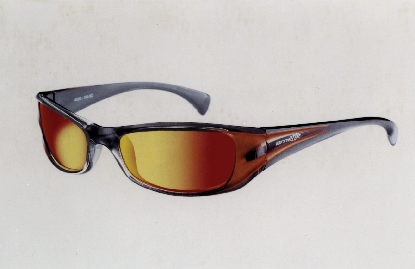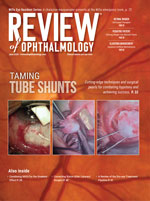Selling sunglasses might be easily left to the retailers, but they really should be dispensed by eye-care professionals. Here are six reasons to offer sunglasses in your dispensary or beef up the program you already have.
Children
Research shows that damage from ultraviolet rays occurs during years of sun exposure, starting from the earliest age. A Dutch study published this year asserts that UV radiation is a definite risk factor for certain types of cataract and UV exposure at a very young age is more detrimental than exposure in adulthood.1
To meet American National Standards Institute standards for "general purpose" sunglasses, the ones you offer for kids should have medium- to dark-tinted lenses that block at least 95 percent of UVB rays, 60 percent of UVA rays and 60 to 92 percent of light.
Cataracts and Retinal Pathology
A Japanese study published this year finds that "exposure after the teenage years correlated with the presence of nuclear opacities in females. The results indicate that the effect of UVB exposure is greater for nuclear than for cortical opacities."2
 |
Patients who spend long hours in the sun or are in very bright environments, defined by the ANSI as tropical beaches, mountain climbing and skiing, should be wearing lenses that block at least 99 percent of UVB rays, 60 percent of UVA rays and 20 to 97 percent of light.
Melanoma
While the development of ocular mela-noma is rare, it seems to be linked with sun exposure, especially in areas near the equator. An Australian study published this year found that the rate of ocular melanoma was much higher in native-born Australians than in persons born in Europe or Asia.4 Because ocular melanoma occurred more often in persons with higher sun exposure, light-colored eyes (dark eyes may transmit less light to the choroid) and in ocular sites known to receive the highest exposure to sunlight, the study concludes there is "a role for solar radiation in the etiology of ocular melanoma."
More of a threat to the U.S. population is melanoma of the skin, which is on the rise, according to several recent studies.5-7 They confirmed damage in young people as well as in non-Caucasian populations. Sunglasses can help protect the periorbital skin from UV damage as they protect the eyes themselves.
Drivers
On the road, a good pair of sunglasses can prevent misjudgments and accidents due to glare. Almost anyone who commutes should have a pair of polarized sunglasses, and these lenses are also recommended for drivers affected by nighttime glare from headlights. Polarized sunglasses can also be used indoors by light-sensitive patients or by those exposed to bright light through windows.
Contact Lens Wearers
Patients who wear contact lenses are more photophobic in bright light. Offer a good pair of sunglasses as part of your contact lens "starter" package. For contact lens patients who are swimmers, a pair of prescription sunglasses will encourage them to remove contact lenses be-fore going to the pool or beach.
Sports
The need for sunglasses is a given for outdoor sports. Water-sports enthusiasts will benefit from polarized sunglasses to cut the glare off the water. And golfers may appreciate photochromic lenses that provide sunglasses protection on the course, but lighten up inside the clubhouse.
Recommending impact-resistant sunglasses to your patients who play high-impact sports may also save someone from eye injury. Your patients who engage in snow sports should be protected from painful photokeratitis with sunglasses or ski goggles, with or without a prescription. Polarized lenses are sometimes recommended to reduce the glare from sunlight reflecting off of snow, but some experts think they don't provide the contrast sensitivity the eye needs to distinguish ice patches or moguls. Lenses in a yellow-orange hue, which block the hazy end of the spectrum, may be better for this.
1. de Gruijl FR, Longstreth J, Norval M, Cullen AP, Slaper H, Kripke ML, Takizawa Y, van der Leun JC. Health effects from stratospheric ozone depletion and interactions with climate change. Photochem Photobiol Sci 2003;2:1:16-28.
2. Hayashi LC, Hayashi S, Yamaoka K, Tamiya N, Chikuda M, Yano E. Ultraviolet B exposure and type of lens opacity in ophthalmic patients in Japan. Sci Total Environ 2003;302:1-3:53-62.
3. Taylor HR, West S, Munoz B, Rosenthal FS, Bressler SB, Bressler NM. The long-term effects of visible light on the eye. Arch Ophthalmol 1992;110:1:99-104.
4. Vajdic CM, Kricker A, Giblin M, McKenzie J, Aitken J, Giles GG, Armstrong BK. Incidence of ocular melanoma in Australia from 1990 to 1998. Int J Cancer 2003;105:1:117-22.
5. Davis KJ, Cokkinides VE, Weinstock MA, O"Connell MC, Wingo PA. Summer sunburn and sun exposure among US youths ages 11 to 18: national prevalence and associated factors. Pediatrics 2002 Jul;110(1 Pt 1):27-35.
6. Leong SP. Future perspectives on malignant melanoma. Surg Clin North Am 2003 Apr;83(2):453-6.
7. Johnson DS, Yamane S, Morita S, Yonehara C, Wong JH. Malignant melanoma in non-Caucasians: experience from Hawaii. Surg Clin North Am 2003 Apr;83(2):275-82.






